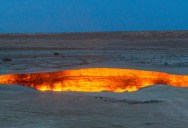4 Places In The World That People Once Believed Led To The Underworld

If there’s one thing that’s been true about human beings since almost the beginning, it’s that we love our drama.
At least, some of us do.
We also love to use fear tactics to control people, for better or worse.
That means there are actually several places on Earth known as the “gateway to hell”- some due to a belief that they were actual gateways to the underworld and others because of impressive geologic composition or volcanic activity.
The oldest site is likely Pluto’s Gate in Turkey.

It’s located in Pamukkale in southwestern Turkey, on a site that was known as a ploutonion. A religious temple to Pluto (Hades) sat atop it, and the site was excavated in 2013.
The temple was built with a gateway and arena that led into a cave that was off-limits to visitors. Priests were allowed to enter, and people sat on raised seats above the cave while the priests conducted their ceremonies.
The events took place at sunrise as bulls entered the cave, but immediately dropped dead while the priests looked calmly on.
We know now this is caused by a leaking of volcanic carbon dioxide, which causes death if you get too close. The priests knew how far away to stand while encouraging the bulls closer for the spectacle of it all.
Next up, Hell’s Gate National Park in Kenya, which is located in Nakuru County.

It is located between Lake Naivasha and the Longonot and Suswa volcanoes, and the national park is filled with breathtaking scenery.
It’s the Ol Jorowa Gorge that’s the actual “gate to hell;” the gorge runs through the center of the park.
It was formed through a mix of volcanic processes and tectonic activity that has been going on for millions of years. The gorge was carved out by water, and contains geysers and hot springs that spurt hot, volcanic water.
Third on our list is the Darvaza crater in Turkmenistan, a modern and man-made gate to the underworld.

The Soviets were looking for oil fields in 1971, searching the Karakum Desert in Turkmenistan. Instead of oil, they tapped into a huge pocket of natural gas.
The rigging station collapsed and created a hole 230 feet across and 66 feet deep, known now as the Darvaza crater.
Its creation led to more craters appearing across the landscape, all of which issue methane, which is a hazard to local wildlife and communities.
Someone had the bright idea to light the gas on fire to “burn it off,” but that didn’t happen and the fires have been burning ever since.
Last on our list is the Batagaika Crater in Siberia. It’s located in the Batagaika “megaslump,” which was discovered in the 1960s after deforestation disturbed the ground’s permafrost.

This destabilized the ground until it weakened and collapsed.
It’s not hard to see why locals would call the 328 foot deep, 0.6 mile long gash a gate to hell – and that’s before you learn that it’s continuing to enlarge every year.
As long as climate change is an issue, the deepening and widening will only continue to get bigger, because the permafrost that’s holding the ground together will continue to melt.
I bet there are even more, but these are probably the most well known.
If things continue the way they’re going, we might have a few more in the near future.
If you thought that was interesting, you might like to read about the mysterious “pyramids” discovered in Antarctica. What are they?

Sign up to get our BEST stories of the week straight to your inbox.




